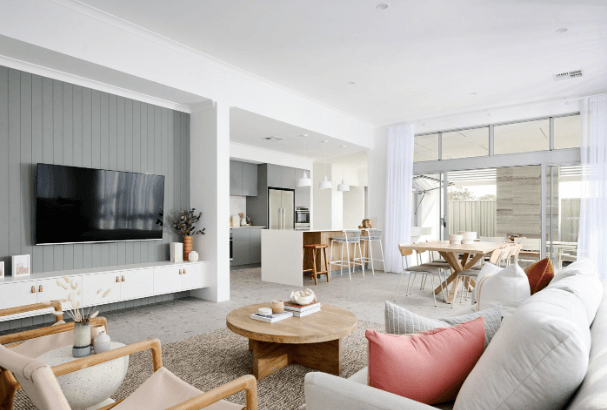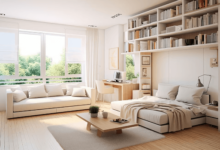How to Personalize Your Home: Tips for Homeowners to Showcase Style

When it comes to making a house feel like a home, personalization is key. Every homeowner dreams of a space that reflects their unique style and personality. But how do you achieve that without turning your home into a chaotic mix of mismatched elements? This blog post is here to help! We’ll walk you through easy and effective ways to infuse your personal touch into every corner of your living space, ensuring it feels truly yours.
Why Personalization Matters in Home Design
Personalization is more than just a trend; it’s a way to make your home a true sanctuary. When you personalize your space, you create an environment that speaks to who you are and what you love. This not only enhances your daily living experience but also makes your home a welcoming space for guests. Whether it’s a favorite color scheme or a collection of artwork, these elements can tell a story about you and your family.
See also: The Essentials of First Home Buyer Loans: What Every New Homeowner Needs to Know
Finding Your Aesthetic
The Importance of Identifying Your Style
Before you start redecorating, it’s crucial to identify your personal style. Are you drawn to minimalist design, or do you prefer a cozier, rustic vibe? Understanding your aesthetic will guide your choices and help you create a cohesive look throughout your home. Inspiration can come from anywhere—a favorite vacation spot, a cherished piece of clothing, or even your local coffee shop’s decor.
Exploring Different Styles
There are countless styles to explore, from modern and industrial to shabby chic and vintage. Spend some time browsing interior design magazines, websites, or social media platforms like Pinterest to gather ideas. Create a mood board to visualize how different elements might come together in your space. Remember, there’s no right or wrong—just what feels right for you.
Mixing and Matching for a Unique Look
Once you’ve identified your style, don’t be afraid to mix and match elements. Combining different textures, colors, and materials can add depth and interest to your home. For example, pairing sleek, modern furniture with a vintage rug can create a stunning contrast that showcases your unique taste.
Personalizing Key Living Spaces
Living Room
Your living room is often the heart of your home, so it should be as inviting as it is personal. Consider adding statement pieces like a bold sofa or a unique coffee table. Incorporate personal touches with family photos, artwork, and souvenirs from your travels. A well-placed bookshelf with your favorite reads can also enhance the room’s character.
Kitchen
The kitchen is another vital area for personalization. If you’re considering a renovation, think about incorporating materials that reflect your style, such as sleek granite countertops in Salt Lake City or colorful ceramic tiles. Personalized kitchen utensils, a curated selection of cookbooks, and even a small herb garden can make this space truly yours.
Bedrooms
Bedrooms are personal sanctuaries where you can express yourself freely. Choose bedding that resonates with your style, and layer it with throws and cushions for added comfort. Consider a feature wall with patterned wallpaper or a striking color to create visual interest. Small personal items like jewelry dishes or framed photos can tie the room together.
Utilizing Accessories and Art
Choosing the Right Accessories
Accessories are the finishing touches that can make all the difference in a room. Think about what items you use daily and those that bring you joy just by looking at them. From vases and candles to quirky knick-knacks, the right accessories can enhance your home’s ambiance and reflect your personality.
Incorporating Art for a Personal Touch
Art is one of the most powerful ways to personalize your home. Choose pieces that speak to you, whether they are from a local artist or something you created yourself. Art can serve as a focal point in a room or complement existing decor. Don’t be afraid to mix different styles and mediums for a gallery wall effect.
Displaying Collections and Memorabilia
If you have a collection or items with sentimental value, find a way to incorporate them into your decor. This could be anything from vintage cameras to concert memorabilia. Displaying these items not only adds character to your home but also serves as a conversation starter for guests.
Lighting and Color Schemes
Lighting as a Design Element
Good lighting is essential for both functionality and aesthetics. Use a mix of natural and artificial light to set the mood in each room. Consider statement light fixtures like a chandelier or pendant lights to add drama and elegance. Smart lighting systems can also be a great addition, allowing you to adjust the ambiance at the touch of a button.
Choosing Colors That Reflect You
Color plays a significant role in personalizing your home. Whether you prefer bright, bold shades or more subdued tones, your choice of color can dramatically affect the atmosphere of a room. Try using accent walls or colorful accessories to inject vibrancy without overwhelming the space.
Playing with Patterns and Textures
Patterns and textures add depth to any room. Incorporate them through textiles like cushions, rugs, and curtains, or through patterned wallpaper and textured paint. Mixing different patterns and textures can create a rich, layered look that feels inviting and personal.
Bringing the Outdoors In
Indoor Plants for a Lively Touch
Plants are a fantastic way to bring life and freshness into your home. They can add color, texture, and even improve air quality. Choose plants that suit your lifestyle—low-maintenance succulents for a busy schedule or lush ferns for a more tropical feel.
Creating an Indoor Garden
If you’re a plant enthusiast, consider creating a dedicated indoor garden. This could be a vertical garden in your kitchen or a sunlit corner in the living room filled with a variety of potted plants. An indoor garden can offer a serene escape and a touch of nature.
Using Natural Materials
Incorporate natural materials like wood, stone, and linen to create a warm, organic feel. Wood furniture, stone fireplaces, and linen textiles can add a grounding element to your home, making it feel more connected to nature.
Conclusion
Personalizing your home is a rewarding process that allows you to express yourself creatively. By understanding your style, choosing meaningful elements, and incorporating personal touches, you can create a space that truly feels like home. Remember, your home is an extension of who you are—make it a place that brings you joy and comfort every day.
For further inspiration and guidance, consider consulting with an interior designer or exploring online resources to continue honing your style.



